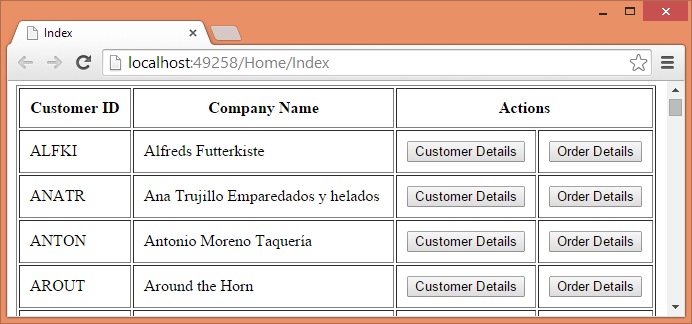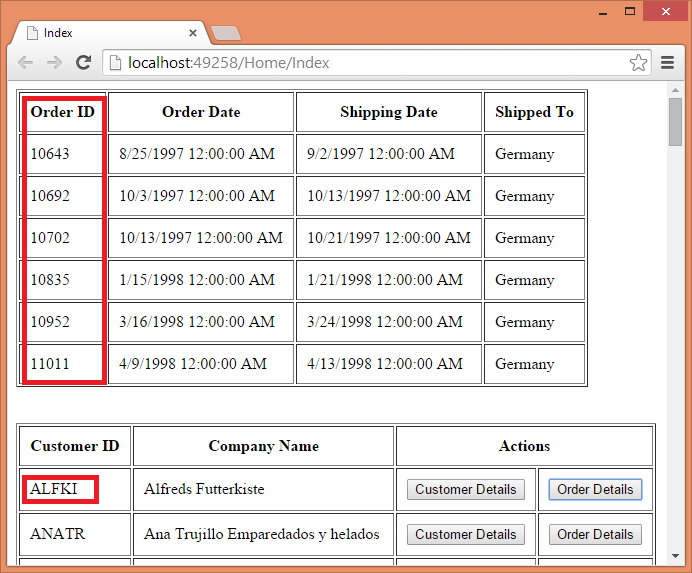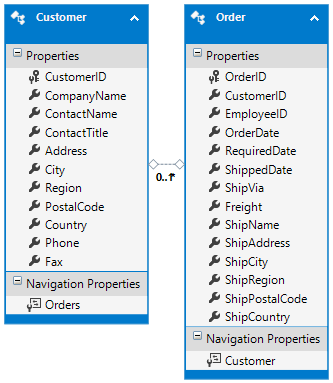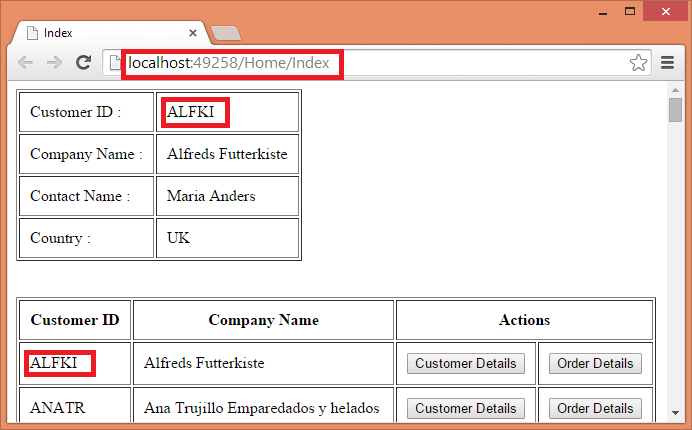[转]Load ASP.NET MVC Partial Views Dynamically Using jQuery
本文转自:http://www.binaryintellect.net/articles/218ca630-ba50-48fe-af6e-6f754b5894aa.aspx
Most of the times ASP.NET MVC views are rendered as a result of user navigating to some action. For example, when a user navigates to /home/index in the browser (either through address bar or through a hyperlink), ASP.NET MVC executes the action method and usually returns a view to the browser. This means each view is rendered as a result of a full GET or POST request. At times, however, you may want to load views dynamically through Ajax. This way you can render contents of a view without full page refresh.
Consider the following page:

The above page consists of a table that lists customers from the Customers table of Northwind database. Each customer row has two buttons - Customer Details and Order Details. Clicking on the respective button should display customer details and order details from the database. Without Ajax you would have submitted the page back to the server and then returned a view with the corresponding details. Using Ajax you can display the details without causing any postback to the server. This is shown below:

As you can see the above figure shows order details for CustomerID ALFKI above the customers table. These details are fetched via Ajax request.
While displaying data through Ajax request you have two options:
- Fetch raw data from the server and embed it in HTML markup on the client side
- Fetch HTML markup with data embedded from the server
Although the choice of the approach depends on a situation, it can be said that the former approach is suitable to make calls to Web API or when HTML display is dynamically decided by the client script. The later approach is suitable when ASP.NET MVC strongly typed views (or partial views) are being used to render the UI. In this example we will be using the later approach.
To develop this example, create a new ASP.NET MVC application based on the Empty template. Then add ADO.NET Entity Data Model for Customers and Orders tables of Northwind database. The Customer and Order entities are shown below:

Next, add HomeController and write the Index() action method as shown below:
public ActionResult Index()
{
using (NorthwindEntities db = new NorthwindEntities())
{
List<Customer> model = db.Customers.ToList();
return View(model);
}
}
The Index() action simply retrieves all the Customer entities from the Customers DbSet and passes them to the Index view.
Now, add another action method - GetView() - to the HomeController as shown below:
public ActionResult GetView(string customerID,string viewName)
{
object model = null;
if(viewName=="CustomerDetails")
{
using(NorthwindEntities db=new NorthwindEntities())
{
model = db.Customers.Find(customerID);
}
}
if (viewName == "OrderDetails")
{
using (NorthwindEntities db = new NorthwindEntities())
{
model = db.Orders.Where(o => o.CustomerID == customerID)
.OrderBy(o => o.OrderID).ToList();
}
}
return PartialView(viewName,model);
}
The GetView() action method accepts two parameters - customerID and viewName. These two parameters are passed through an Ajax request. Depending on the viewName parameter either CustomerDetails partial view is returned to the caller or OrderDetails partial view is returned. These two view need model in the form of a Customer object and a List of Order entities respectively. That's why model variable is declared as object. Once model variable is populated the partial view name and the model is passed to the PartialView() method. Here, we used partial views because the HTML output is to be inserted in an existing page through Ajax.
Next, add one view (Index.cshtml) and two partial views (CustomerDetails.cshtml and OrderDetails.cshtml) to the Home sub-folder of Views folder.
Add the following markup to the CustomerDetails.cshtml partial view:
@model MVCViewsThroughAjax.Models.Customer <table border="1" cellpadding="10">
<tr>
<td>Customer ID :</td>
<td>@Model.CustomerID</td>
</tr>
<tr>
<td>Company Name :</td>
<td>@Model.CompanyName</td>
</tr>
<tr>
<td>Contact Name :</td>
<td>@Model.ContactName</td>
</tr>
<tr>
<td>Country :</td>
<td>@Model.Country</td>
</tr>
</table>
The above markup is quite straightforward. The CustomerDetails partial view simply displays CustomerID, CompanyName, ContactName and Country of a Customer in a table.
Now add the following markup to the OrderDetails.cshtml partial page:
@model List<MVCViewsThroughAjax.Models.Order> <table border="1" cellpadding="10">
<tr>
<th>Order ID</th>
<th>Order Date</th>
<th>Shipping Date</th>
<th>Shipped To</th>
</tr>
@foreach(var item in Model)
{
<tr>
<td>@item.OrderID</td>
<td>@item.OrderDate</td>
<td>@item.ShippedDate</td>
<td>@item.ShipCountry</td>
</tr>
}
</table>
The above markup iterates through the List of Order entities and renders a table with four columns - OrderID, OrderDate, ShippedDate and ShipCountry.
Now, add the following markup to the Index view:
@model List<MVCViewsThroughAjax.Models.Customer> ...
<html>
<head>
...
</head>
<body>
<div id="viewPlaceHolder"></div>
<br /><br />
<table border="1" cellpadding="10">
<tr>
<th>Customer ID</th>
<th>Company Name</th>
<th colspan="2">Actions</th>
</tr>
@foreach(var item in Model)
{
<tr>
<td>@item.CustomerID</td>
<td>@item.CompanyName</td>
<td><input type="button" class="customerDetails"
value="Customer Details" /></td>
<td><input type="button" class="orderDetails"
value="Order Details" /></td>
</tr>
}
</table>
</body>
</html>
The Index view receives a List of Customer entities as its model and renders a table with CustomerID, CompanyName and two buttons - Customer Details and Order Details.
Now comes the important part - making Ajax calls to display customer details and order details. Noticed the <div> at the beginning of the body section? The viewPlaceHolder is where the output of CustomerDetails.cshtml and OrderDetails.cshtml will be loaded. To do so we will use load() method of jQuery. Here is how that can be done:
$(document).ready(function () {
$(".customerDetails").click(function (evt) {
var cell=$(evt.target).closest("tr").children().first();
var custID=cell.text();
$("#viewPlaceHolder").load("/home/getview",
{ customerID: custID, viewName: "CustomerDetails" });
});
$(".orderDetails").click(function (evt) {
var cell = $(evt.target).closest("tr").children().first();
var custID = cell.text();
$("#viewPlaceHolder").load("/home/getview",
{ customerID: custID, viewName: "OrderDetails" });
});
});
Recollect that Customer Details and Order Details buttons have assigned CSS class of customerDetails and orderDetails respectively. The above jQuery code uses class selector to wire click event handlers to the respective buttons. Inside the click event handler of Customer Details button, the code retrieves the CustomerID from the table row. This is done using closest(), children() and first() methods. The CustomerID is stored in custID variable. Then load() method is called on viewPlaceHolder <div>. The first parameter of the load() method is the URL that will be requested through an Ajax request. The second parameter is a JavaScript object that supplies the data needed by the requested URL. In our example, GetView() action method needs two parameters - customerID and viewName. Hence the object has customerID and viewName properties. The customerID property is set to custID variable and viewName is set to CustomerDetails.
The click event handler of Order Details is similar but loads OrderDetails partial view.
That's it! You can now run the application and try clicking on both the buttons. The following figure shows customer details loaded successfully.

Notice that through out the application run the URL shown in the browser address bar remains unchanged indicating that Ajax requests are being made to display customer details and order details.
In the above example Ajax requests were made to /home/getview action. A user can also enter this URL in the browser's address bar producing undesirable results. As a precaution you can check the customerID and viewName parameters inside the GetView() action method (not shown in the above code). If these parameters are empty or contain invalid values you can throw an exception.
[转]Load ASP.NET MVC Partial Views Dynamically Using jQuery的更多相关文章
- 【番外篇】ASP.NET MVC快速入门之免费jQuery控件库(MVC5+EF6)
目录 [第一篇]ASP.NET MVC快速入门之数据库操作(MVC5+EF6) [第二篇]ASP.NET MVC快速入门之数据注解(MVC5+EF6) [第三篇]ASP.NET MVC快速入门之安全策 ...
- ASP.NET MVC的客户端验证:jQuery的验证
之前我们一直讨论的Model验证仅限于服务端验证,即在Web服务器根据相应的规则对请求数据实施验证.如果我们能够在客户端(浏览器)对用户输入的数据先进行验证,这样会减少针对服务器请求的频率,从而缓解W ...
- 使用RazorEngine对ASP.NET MVC的Views进行UnitTest
有的时候我们需要对Razor最后生产的文本(HTML OR XML OR..)进行单元测试. 使用Nuget安装RazorEngine. 新建一个ASP.NET MVC项目,并且带有测试项目. 修改I ...
- asp.net mvc Partial OutputCache 在SpaceBuilder中的应用实践
最近给SpaceBuilder增加OutputCache 时发现了一些问题,贴在这做个备忘,也方便遇到类似问题的朋友查阅. 目前SpaceBuilder表现层使用是asp.net mvc v1.0,使 ...
- ASP.NET MVC 4 (十一) Bundles和显示模式--asp.net mvc中 @Scripts.Render("~/bundles/jquery")是什么意思? 在布局文件中使用Scripts.Render()输出脚本包,Styles.Render()输出风格包:
ASP.NET MVC 4 (十一) Bundles和显示模式 ASP.NET MVC 4 引入的js打包压缩功能.打包压缩jquery目录下的文件,在布局文件中使用Scripts.Render()输 ...
- ASP.NET MVC的客户端验证:jQuery验证在Model验证中的实现
在简单了解了Unobtrusive JavaScript形式的验证在jQuery中的编程方式之后,我们来介绍ASP.NET MVC是如何利用它实现客户端验证的.服务端验证最终实现在相应的ModelVa ...
- ASP.NET MVC Partial页输出JS
很多情况Partial是需要引用到JS的,通常做法是吧JS在引用Partial的页面中加入JS文件或者JS代码. 前阵子网上看到一段代码可以在Partial页面中添加JS,输出道引用页面. publi ...
- [ASP.NET MVC]@Partial 和@RenderPartial的区别
@Partial 和@RenderPartial的区别 Html.partial和RenderPartial的用法与区别 Html.partial和RenderPartial都是输出html片段,区别 ...
- ASP.NET MVC中,怎么使用jquery/ajaxForm上传文件
ajaxForm插件最好选择:jquery forms plugin. 以下为示例: Ajax.BeginForm @using (Ajax.BeginForm("YourAction&qu ...
随机推荐
- SSH的三个组件ssh、sftp、scp介绍
SSH 包含3个组件 (1) ssh 远程登录节点 : ssh 用户名@IP地址 ① 不允许空密码或错误密码认证登录 ② 不允许root用户登录 ③ 有两个版本 ssh,ssh2安全性更高 (2) ...
- rest-assured的日志使用介绍
在许多测试用例当中,为了帮助我们创建正确的断言和发送正确的请求,打印出详细的响应和请求数据是非常有用的.为此我们可以使用rest-assured提供的预定义过滤器或者使用其中的一些快捷方法. 一.请求 ...
- CDN基本原理和功能浅析
CDN的全称是Content Delivery Network,即内容分发网络.CDN的通俗理解就是网站加速,CPU均衡负载,可以解决跨运营商,跨地区,服务器负载能力过低,带宽过少等带来的网站打开速度 ...
- 深入剖析PHP输入流 php://input
另附一个一个连接: http://www.nowamagic.net/academy/detail/12220520 ///////////////////////////////////////// ...
- [转]【NODE】用WS模块创建加密的WS服务(WSS)
[From] https://luojia.me/2015/07/21/%E3%80%90node%E3%80%91%E7%94%A8ws%E6%A8%A1%E5%9D%97%E5%88%9B%E5% ...
- Oracle的pipelined函数实现高性能大数据处理
从Oracle 8开始,我们就可以从一个collection类型的数据集合中查询出数据,这个集合称之为"虚拟表".它的方法是"SELECT FROM TABLE(CAST ...
- 中间件使用之(UA,IP,selenium)的使用
一.UA池:User-Agent池 - 作用:尽可能多的将scrapy工程中的请求伪装成不同类型的浏览器身份. - 操作流程: 1.在下载中间件中拦截请求 2.将拦截到的请求的请求头信息中的UA进行篡 ...
- mysql把之前表单进行拆分
今天有个任务是需要把之前的历史数据做一个清理. 原历史数据 很多电话号码是放到了一起.所以需要新建一个联系方式表.然后进行增加 新建表格如下: 然后再进行查询数据. SELECT a.uid,subs ...
- 理解Call、Apply、bind
Apply.call 共同点: 为了改变函数执行时的上下文(简单说就是为了改变当前函数体内的This的指向) 不同点: 传入的参数不一样,func.apply(this,[arg1,arg2]).fu ...
- 协程:gevent模块,遇到i/o自动切换任务 038
协程 : gevent模块,遇到io自动切换任务 from gevent import monkey;monkey.patch_all() # 写在最上面 这样后面的所有阻塞就全部能够识别了 impo ...
